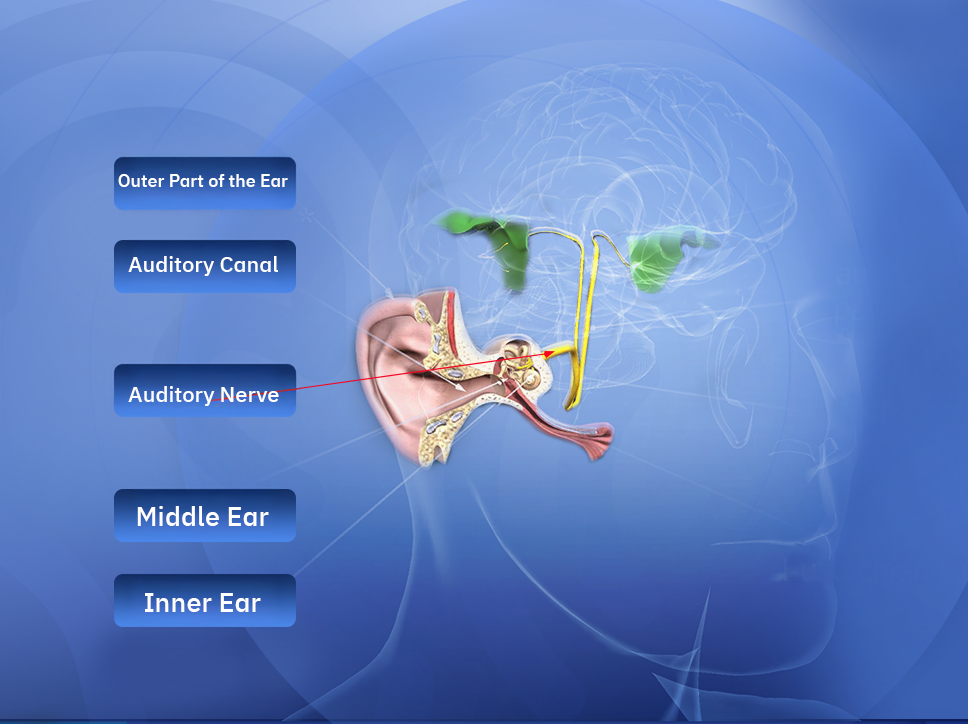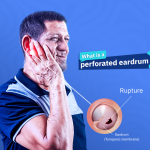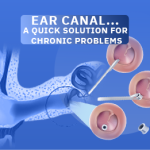Auditory Nerve

The reason behind this lies in the Auditory Nerve—also known as the cochlear or vestibular nerve—which connects the ears to the brain. It acts as a bridge that transmits nerve signals from the ear to the brain, allowing you to hear the sounds around you. It also helps maintain your balance, as it consists of a bundle of nerves divided into:
The vestibular nerve, primarily responsible for body balance and eye movement.
The cochlear nerve (Auditory Nerve), which is responsible for hearing.
But do you know how the Auditory Nerve works?
That’s what we’ll explore in the following lines as we detail the journey of sound from the ear to the brain through the Auditory Nerve. Stay with us.
- Components of the Auditory System
- Role of the Auditory Nerve in Hearing and Balance
- Diseases Affecting the Auditory Nerve
Components of the Auditory System
To understand how the Auditory Nerve functions, it’s essential to know the ear’s components and how sound travels from the external environment to the brain via the Auditory Nerve. Let’s look at the inner structure of the ear to better grasp how this nerve works.
The ear consists of three main parts: the outer ear, the middle ear, and the inner ear. Each of these parts contains components that play a vital role in converting sound—starting from capturing it through the outer ear, all the way to interpreting it in the brain through the Auditory Nerve.
The Outer Ear:
The visible external part of the ear, comprising:
Auricle (pinna): Responsible for capturing sound from the surrounding environment.
- Ear canal: Receives sound waves collected by the auricle and transmits them to the eardrum.
The Middle Ear:
An air-filled cavity that contains three small bones:
Malleus (hammer): Connects the eardrum to the middle ear.
Incus (anvil): Located in the middle of the three bones.
Stapes (stirrup): Links the middle ear to the inner ear.
The middle ear connects to the back of the nose and the upper part of the throat via the Eustachian tube, which opens and closes to drain fluids and maintain balanced pressure within the middle ear—helping the ear function efficiently.
The Inner Ear:
Composed of interconnected fluid-filled chambers, including:
The cochlea: Contains fluid called lymph and highly sensitive hair cells. When sound waves reach the cochlea via the middle ear bones, they cause the cochlear walls to vibrate, which affects the fluid. This motion stimulates the hair cells, converting the vibrations into electrical impulses that are transmitted via the Auditory Nerve to the brain, where they are interpreted as sound.
- The vestibular labyrinth: Consists of fluid-filled semicircular canals that contain sensory hair cells. When you move or turn your head, the fluid shifts, activating the hair cells to help maintain your body’s balance.
Role of the Auditory Nerve in Hearing and Balance
Hearing:
Hearing begins when sound waves hit the eardrum, causing it to vibrate. These vibrations travel through the three middle ear bones, reaching the fluid in the cochlea. The cochlear hair cells then send electrical signals via the Auditory Nerve to the brain, which interprets them as sound.
Balance:
Any motion you make is converted into signals sent through the vestibular nerve to the brain, allowing your body to understand its position and direction, thereby helping you maintain balance.
The Auditory Nerve is a sensory nerve essential for both hearing and balance. It can be affected by certain diseases, potentially leading to hearing loss or balance disorders. Therefore, it’s crucial to consult an ENT specialist if you experience symptoms indicating a problem with the Auditory Nerve.
Diseases Affecting the Auditory Nerve
Vestibular Neuritis:
Also called vestibular neuritis, this condition is often caused by a viral infection and can affect the Auditory Nerve.
Symptoms may include:
Difficulty understanding speech despite hearing it.
Hearing loss.
Sudden dizziness and loss of balance, especially during physical activity.
Nausea and vomiting.
Blurred vision.
Risk factors include:
Family history.
Migraines.
Middle ear infections.
Noise exposure.
Diagnosing Vestibular Neuritis:
Family history.
Migraines.
Middle ear infections.
Noise exposure.
Treatment of Auditory Nerve Inflammation
Treatment depends on the severity of symptoms and extent of hearing damage. Options may include:
Hearing aids: To improve hearing for some patients.
- Cochlear implants: Used in severe cases where hearing aids are not sufficient.
Treatment of Dizziness and Loss of Balance:
Medications: A doctor may prescribe medications that help relieve dizziness and nausea.
Physical Therapy: Physical therapy can assist in improving balance and reducing vertigo.
Brain Training: The brain can be trained to adapt to imbalance through exercises prescribed by an ENT (ear, nose, and throat) specialist.
Treatment of Tinnitus:
Medications: Certain medications may help alleviate tinnitus symptoms.
Behavioral Therapy: Behavioral therapy can assist in managing the impact of tinnitus.
An ENT (ear, nose, and throat) specialist may also prescribe other medications such as:
Antiemetics, antihistamines, and sedatives to help control nausea and vomiting caused by vertigo.
Auditory Nerve Tumor:
An Auditory Nerve Tumor is a non-cancerous growth that affects the vestibular part of the Auditory Nerve. Although it grows slowly, its impact can be significant, as it affects both hearing and body balance. This tumor develops and spreads along the Auditory Nerve, which is responsible for transmitting hearing and balance signals from the ear to the brain.
Its symptoms may resemble those of Auditory Nerve inflammation, which is why visiting an ENT (ear, nose, and throat) specialist is essential for an accurate diagnosis and to begin the appropriate treatment journey.
Symptoms of an Auditory Nerve Tumor:
Over time, the tumor puts increasing pressure on the Auditory Nerve, leading to concerning symptoms such as:
Hearing loss: It may begin gradually in one ear and become more noticeable as the tumor grows.
Tinnitus: A persistent and bothersome ringing in the affected ear.
Dizziness and imbalance: The patient may experience vertigo or feel unsteady while standing or walking.
Speech difficulties: The patient may have trouble articulating words clearly.
Stages of an Auditory Nerve Tumor:
An Auditory Nerve Tumor progresses through four stages based on its size:
Stage 1 (Small tumors): The tumor may not cause any symptoms and can be monitored with regular check-ups.
Stage 2 (Medium tumors): Some symptoms may appear, such as hearing loss or tinnitus, and these can often be managed with radiation therapy or surgery.
Stage 3 (Larger tumors): Symptoms become more pronounced, and medical intervention becomes more necessary.
Stage 4 (Large tumors): The tumor may threaten vital brain functions, making surgical treatment extremely urgent.
Treatment of Auditory Nerve Tumor:
The treatment of an Auditory Nerve Tumor depends on the tumor’s stage and the extent of its impact on hearing and balance functions. Treatment options include:
Observation: In the early stages, the doctor may choose to monitor the tumor through regular check-ups.
Radiation therapy: Used to stop the tumor from growing or to shrink its size.
Surgery: Performed to remove the tumor and is considered the best option in advanced stages.
It is essential to protect the Auditory Nerve by avoiding exposure to loud noise and seeking immediate medical attention in case of ear infections. This helps safeguard the nerve from potential disorders. The Auditory Nerve is a vital gateway to the external world, playing a key role in both the hearing process and maintaining the body’s balance.







